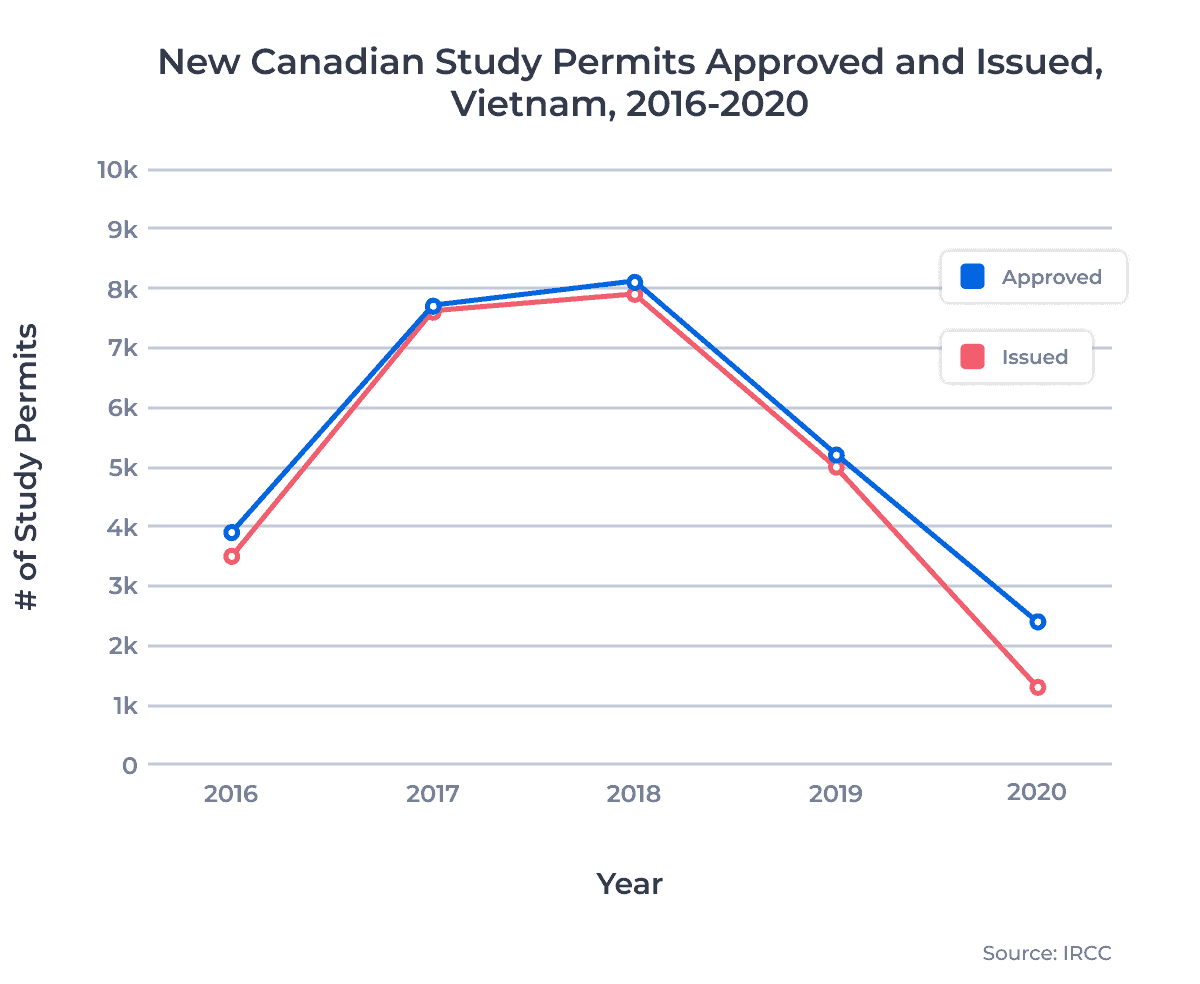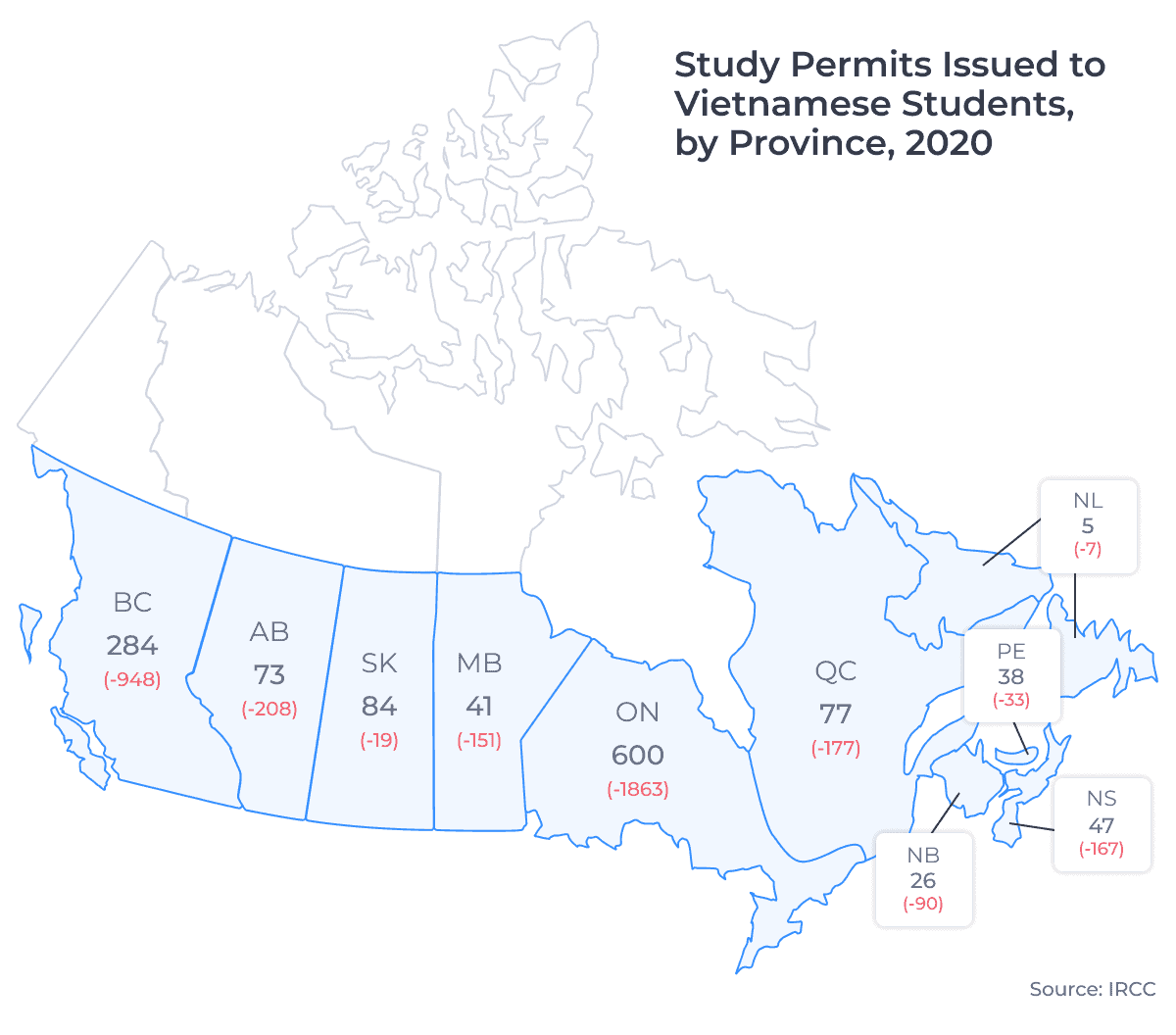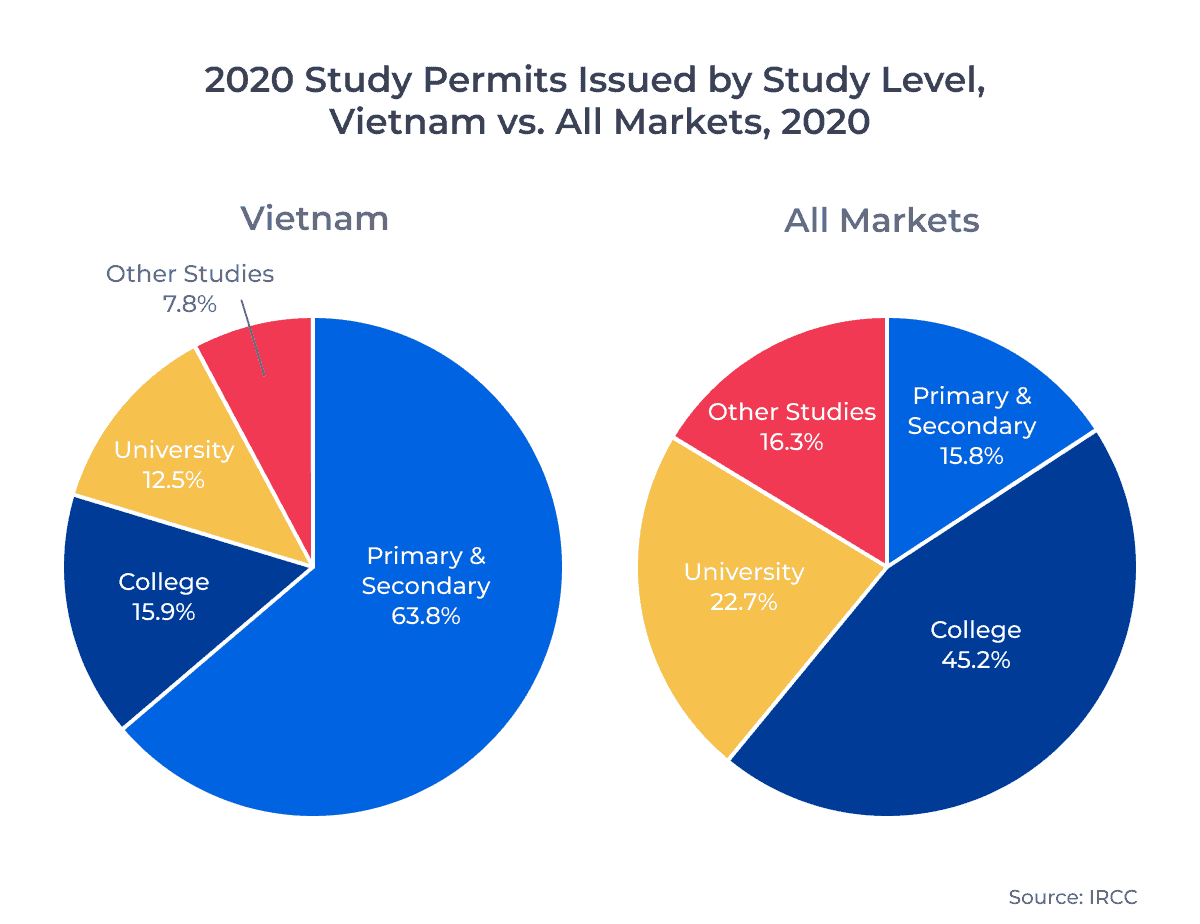In 2019, Vietnam was the ninth-largest source market for new international students to Canadian institutions.1 It was the top supplier of Southeast Asian students to Canada and a market that looked poised to grow throughout 2020. But when COVID-19 struck, Vietnam was hit hard. In 2020, the number of new study permits issued to Vietnamese students fell by 74.4%, slightly outpacing the all-market decline of 73.5%.
In this edition of ApplyInsights, I’ll sift through Vietnamese study permit data to uncover the trends that emerged from the largest Southeast Asian market over the past three years. I’ll cover what students from Vietnam are studying, where they’re choosing to study within Canada, and I’ll talk about what Canadian schools can do to attract Vietnamese students to their institutions post-pandemic.
Key Insights at a Glance
- Vietnamese applicants experienced a 12.8% increase in approval rate from 2019 to 2020, well above the 0.5% average increase for Southeast Asian students within that time period.
- 63.8% of all issued study permits to Vietnamese students in 2020 were at the primary and secondary school level.
- Vietnam sent the fourth-most students to institutions in Atlantic Canada among all source markets over the past 5 years.
- Vietnamese college and university students were 10% more likely to be approved for a new Canadian study permit than college and university students across all other markets.
This is the seventh article in our ApplyInsights series examining the top international student markets in Canada. We’ve previously explored trends from Hong Kong, Algeria, Brazil, China, the Philippines, and Bangladesh, and we’ll continue sharing findings from more key markets over the course of this year.
Canadian Study Permit Applications and Approval Rates – Vietnam
Vietnamese nationals submitted 10,577 new study permit applications to attend schools in Canada in 2019. Those applications accounted for just over 50% of all applications from Southeast Asian countries during that year. Vietnam was also the ninth-largest source country for international students in Canada overall and the largest source country among Southeast Asia. With a steady climb up the rankings of source countries by study permits issued since 2016, things were trending upwards.
But as the table below shows, the COVID-19 pandemic hit Vietnam harder than most:
| 2019 | 2020 | % Change | ||
|---|---|---|---|---|
| Vietnam | Applications | 10,577 | 3,881 | -63.3% |
| Approvals | 5,169 | 2,393 | -53.7% | |
| Approval Rate | 48.9% | 61.7% | +12.8% | |
| Southeast Asia | Applications | 21,785 | 10,654 | -51.1% |
| Approvals | 12,586 | 6,253 | -50.3% | |
| Approval Rate | 57.8% | 58.7% | +0.9% | |
| All Markets | Applications | 425,990 | 220,932 | -48.1% |
| Approvals | 256,216 | 113,304 | -55.8% | |
| Approval Rate | 60.1% | 51.3% | -8.8% |
Study permit applications for Vietnamese students fell substantially last year, dropping from 2,169 in 2019 to 2,393 in 2020—a decline of 63.3%. This drop-off was nearly 15 percentage points steeper than the decline in applications across all markets.
While this drop-off in application volume was discouraging, there was a silver lining—the approval rate for Vietnamese students. Vietnamese students saw the lowest new Canadian study permit approval rate among Southeast Asian countries in 2019.2 But in 2020, Vietnamese students saw the largest increase in approval rate among the top 20 source countries by study permits issued.
Vietnamese students posted a 12.8% increase in approval rate during 2020, which was 21.6 percentage points higher than the year-over-year shift in the all-market approval rate.
The Ripple Effect of Changes to SDS
Vietnamese students were 10.4% more likely to get approved for a study permit in 2020 than the average international student coming to Canada. What’s driving this?
Conversations I’ve had with our Vietnamese recruitment partners indicate this increase is a product of applicants acclimating to the new visa application process. From 2015 to 2017, the easiest way for a Vietnamese student to get approved for a study permit was via the Canada Express Study (CES) program. When the program—which was largely responsible for the 70 to 76% approval ratings during those years—was cancelled in 2018, it was replaced by the Student Direct Stream (SDS) program.
SDS requires a higher score on the International English Language Testing System (IELTS), and English language proficiency is lower in Vietnam than in other large source markets. This critical difference meant several applicants who would’ve previously been issued a study permit under CES were suddenly ineligible under SDS. These students were forced to apply through the regular stream, which has much more stringent requirements.
This led to the drop in approval rate in 2019. Vietnamese applicants’ familiarity with the visa application process—now in its second year—is likely what’s driving the 2020 increase in approval rates. More prospective students in Vietnam now know whether they should apply via SDS or the regular stream. The result is fewer rejected applications.
Canadian Study Permits Issued – Vietnam
Dating back to 2017, over 97% of study permits approved for Vietnamese students in a given year were issued. In 2020, that rate dipped to just 53.4%. From speaking to our Vietnamese recruitment partners, this decline seems to be a product of non-students attempting to use the Student Direct Stream (SDS) program as a vehicle to leave Vietnam.
The SDS program in Canada was designed to streamline study permit processing for Vietnamese students looking to study at participating institutions across Canada. Learn more about the SDS program’s effect on the Vietnamese market in a previous ApplyInsights post.
Very similar to the behaviour of Indian students that I discussed last month, several Vietnamese citizens were leveraging the SDS program as a way to jumpstart the immigration process. Many would get approved for their study permit applications, but upon review by immigration officials, things like inconsistent study plans, false documents, or unstable finances prevented them from being issued a study permit.
The chart below compares study permits approved and issued for Vietnamese applicants over the past five years:

Despite fewer Vietnamese students arriving in Canada in 2020, Vietnam was still the second-largest source country for Southeast Asian students to Canadian institutions, falling behind the Philippines. In 2020, just under 1,300 new study permits were issued to Vietnamese students.
Another interesting factor contributing to the decline in Vietnamese applications is the average age of applicants. The average age of Vietnamese applicants who applied through our ApplyBoard platform in 2020 was 21 years old. This young age reflects the fact that over 63% of study permits issued to Vietnamese students in 2020 were at the primary and secondary school levels.
I’m extremely optimistic that the Vietnamese market will recover quickly in 2022. As we move towards the return of international travel and as vaccination rates rise, I expect that the majority of SDS applicants will be bona fide prospective students and families will feel more comfortable travelling together. This should help application numbers and approval rates to vault back to full strength. Next year, I expect Vietnam to reclaim their spot atop the regional rankings.
Canadian Study Permits Issued by Province – Vietnam
The map below highlights the number of study permits issued to Vietnamese students for each of Canada’s 10 provinces in 2020. The change in study permits issued between 2019 and 2020 is indicated in red:

Ontario and British Columbia were the two most popular popular destinations among Vietnamese students in 2020. This aligns with almost every source market, as students largely prefer these provinces due to their large metro areas, plentiful work opportunities, and wide variety of schools.
The most interesting trend I’m seeing is the growing appetite among Vietnamese students to study in Atlantic Canada.3 In 2020, 9.1% of all Vietnamese students who were issued new study permits chose to study in Nova Scotia, New Brunswick, Newfoundland and Labrador, or Prince Edward Island. In comparison, only 4.9% of students across all markets chose to study in Atlantic Canada last year.
Nearly four times as many Vietnamese students are attending institutions in Atlantic Canada in 2020 as they were in 2016, with market share growing from 2.5% to 9.1%.
There are a few factors that are likely contributing to this snowballing interest. The first is Atlantic Canada offers schools that are located in low cost rural areas with regional immigration pathways. Another draw for students is the regional representation of schools. There are already several east coast communities with a strong Vietnamese presence. Students value being part of communities where there are already Vietnamese roots laid down. Finally, there’s simply less competition to get into institutions in Atlantic Canada than there is in places like Toronto and Vancouver.
I would strongly recommend institutions across Atlantic Canada capitalize on this interest to inform conversations their admissions teams have with prospective Vietnamese students.
Specifically, I think schools in Atlantic Canada could better connect with Vietnamese students by:
- Communicating with prospective Vietnamese students and their parents via Zalo, WhatsApp and email–the preferred methods of communication in Vietnam
- Advertising the strong primary and secondary schools, childcare supports, and recreational programs in your school’s local community
- Holding virtual or in-person information sessions to educate prospective Vietnamese students and their families on the perks and benefits of studying in Atlantic Canada
Canadian Study Permits Issued by Study Level – Vietnam
The charts below compare study permits issued to Vietnamese students vs. students from all markets in 2020:
Not only did Vietnam lead Southeast Asia in total study permits issued for primary and secondary studies in 2020, but Vietnamese nationals also accounted for the highest proportion of primary and secondary students among all major source markets in 2020.4
By contrast, university study permits fell by 7 percentage points last year, while college study permits decreased by nearly 10 percentage points. However, it turns out that Vietnamese college and university students were 10% more likely to be approved than college and university students across all other markets in 2020.
When I analyzed study permit trends among Hong Kong students earlier this year, I saw similarly high rates of interest in primary and secondary schools. Once again, I suspect this is a pandemic-related decline for the Vietnamese market. I think that the higher approval rates Vietnamese nationals have seen in 2020 bodes well for the growth of university and college applications. I predict we’ll see Vietnam leapfrog back into the top 10 source countries when students and their families deem it’s safe to travel again.
Post-Pandemic Outlook
Vietnam has gone from being one of the world’s greatest COVID-19 success stories to the home of one of the virus’s most stubborn localized outbreaks.
Fortunately, the stringent lockdown measures and recent shipments of vaccine doses should allow Vietnam to return to stable condition within a few month’s time, but it is going to get worse before it gets better. The item that remains up in the air is uncertainty around how Vietnam’s recent outbreak will play out for the future of prospective students.
Our local recruitment partners think we could be looking at one of two scenarios:
- This acts as a wake up call for Vietnamese students and their families, incentivizing parents to bring their to more developed countries like Canada where there is a a world-class medical and education system.
- The recent outbreak incites fear into Vietnamese parents, causing them to question the stability of the COVID-19 virus in other countries, leading them to stay home and keep their children near them.
It’s undeniable that these events could swing Vietnamese citizens in either direction. Having said that, I think it’s important to note that Vietnamese parents typically like to play things safe. Their natural aversion to risk, coupled with the economic downturn Vietnam is experiencing make it unlikely that families will express a desire to relocate this year.
However, once the COVID-19 outbreak is contained and Vietnamese citizens feel comfortable with international travel, study permit applications should rise fast next year. Local recruitment partners suspect a popular route many prospective students will take is studying at local institutions in preparation to transfer their credits to Canadian universities. Given these insights, I’m optimistic that Vietnam is one of the best-suited countries to ignite a swift recovery in 2022.
Key Takeaways
Despite the recent pandemic setback, I see Vietnam’s situation as one to envy for many countries around the world. Stringent pandemic restrictions over the past 18 months ensured that Vietnamese citizens could keep their jobs and their good health. The result was one of the most stable economies in Southeast Asia throughout the COVID-19 crisis.
Prospective students and their families will be ready and financially able to move forward with international education and immigration plans as soon as later this year. Canadian institutions that want to keep pace and target Vietnamese students next year and beyond should consider:
- Promoting primary and secondary education opportunities in their local communities when communicating with prospective Vietnamese students.
- Publishing details online about the local cost of living, specifically for houses that can accommodate larger families.
- Providing institutional services, recreational outlets, and financial support for Vietnamese students looking for childcare assistance.
- Ensuring their admissions departments have the tools they need to process the transfer of credits from Vietnamese institutions next year.
Published: July 26, 2021
Subscribe to ApplyInsights
Sign up for the latest insights on international education.
 Meti Basiri
Meti Basiri
Co-Founder and Chief Marketing Officer (CMO)
Meti is driven by the belief that education is a right, not a privilege. He leads the International Recruitment, Partner Relations, and Marketing teams at ApplyBoard, working to make education accessible to people around the world. Meti has been instrumental in building partnerships with 1,500+ educational institutions across Canada, the United States, the United Kingdom, and Australia. Working with over 5,000 international recruitment partners, ApplyBoard has assisted over 150,000 students in their study abroad journey. Follow Meti on LinkedIn for more access to ApplyInsights and key industry trends.
FOOTNOTES:
1. Statistics used in this article are for new study permits only. All data courtesy of Immigration, Refugees and Citizenship Canada (IRCC), except where noted.
2. Southeast Asian countries with over 100 study permits issued in 2019.
3. Atlantic Canada consists of the following provinces: Nova Scotia, New Brunswick, Newfoundland and Labrador, and Prince Edward Island.
4. Minimum of 450 study permits issued across all study levels in 2020.



